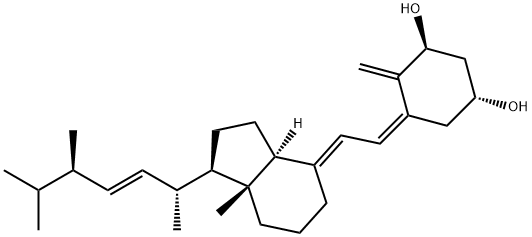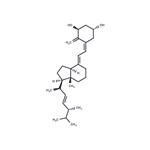Manufacturing Process
Isoergosterone (m.p. 105-106°C) was prepared from ergosterol by the
method described in Shepherd et al., J. Amer. Chem. Soc. 77, 1212 (1955).
To a solution of isoergosterone in 80 ml t-butanol and 1 ml acetic acid, 1.5 g
SeO2 were added, and the mixture was refluxed under nitrogen for 16 hours.
The solvent was then evaporated in vacuo, the residue was redissolved in 150
ml ethanol and 7 ml of 28% aqueous (NH4)2S was added. This solution was
refluxed for 1.5 hours and then kept at room temperature overnight. After
evaporation of the solvent under reduced pressure and addition of CHCl3 the
resulting slurry was filtered through a short Al2O3-column to remove the Se
powder. Concentration of the filtrate and separation of the products on a silicic
acid column gave ca. 1.5 g (30% yield) of 1,4,6,25-ergostatetraen-3-one of
satisfactory purity which was identified by the spectral dates.
To a solution of 1.5 g of the 1,4,6,25-ergostatetraen-3-one in 200 ml MeOH
and 50 ml dioxane, 1 ml 10% NaOH and 6 ml 30% H2O2 were added. The
reaction mixture was kept at room temperature overnight. The solvent wasthen evaporated under reduced pressure, and the product that separated was
collected by suction filtration, washed with water and dried in vacuo. The solid
obtained was redissolved in CHCl3 and applied to a column of 100 g silicic acid
prepared in CHCl3. Elution with CHCl2 gave 1.2 g (77%)of 1α,2α-epoxy-
4,6,22-ergostatnene-3-one which, upon crystallization from methanol/acetone
yielded material having the melting point 143°-145°C.
A solution of 600 mg of the epoxide in 70 ml freshly distilled THF was added
(all at once) to 70 ml liquid ammonia containing 2 g of 30% lithium
dispersion. The reaction mixture was refluxed for 10 min and then 15 g NH4Cl
was added in small portions over a 20 min. After evaporation of the ammonia,
water was added, and the mixture was extracted with ether. The ether layer
was dried over Na2SO4, evaporated, and the residue was applied to a 120 g
silicic acid column poured as a slurry in 20% ether in Skellysolve B. The
column was eluted with 100 ml of 20% ether in Skellysolve B (straight run
aliphatic naphthas (essentially normal hexane) derived from petroleum oil
having a boiling range of 60-68°C, (marketed by Skelly Oil Co.) followed by
250 ml of 50%, and 250 ml of 70% ether in Skellysolve B and finally with 250
ml of ether, 250 ml of 20%, ethyl acetate in ether and 200 ml of 50% ethyl
acetate in ether. 12 ml fractions were collected. Crystallization of the material
in tubes 69-90 (200 mg) from Skellysolve B and ethyl acetate gave the
dihydroxy compound, 1α-hydroxy-7,8-dihydroergosterol having the melting
point 180-182°C.
200 mg of the 1α-hydroxy-7,8-dihydroergosterol was acetylated by dissolving
in pyridine (10 ml) and acetic anhydride (10 ml). The acetylation was done at
80°C for 24 hours. The reaction mixture was extracted with diethylether and
H2O (pH 4 with H2SO4). The ether phase was collected and the aqueous phase
was extracted twice with diethylether and dried under nitrogen gas. The
collected material was subjected to silicic acid column chromatography and
130 mg (54% yield) of the diacetate, 1α-acetoxy-7,8-dihydroergosteryl
acetate was recovered.
To 100 mg of the 1α-acetoxy-7,8-dihydroergosteryl acetate dissolved in 6 ml
Skellysolve B, at 70°C, 4.3 mg of N,N'-dibromodimethylhydantoin was added.
The solution was refluxed with stirring for 15 min, then cooled in an ice bath
and filtered. The filtrate was taken up in 2 ml xylene and added dropwise to a
solution of 0.2 ml trimethylphosphite and 1 ml xylene preheated to 135°C.
The reaction mixture was kept at 135-140°C for 2 hours. After evaporation of
the solvent under reduced pressure the residue was chromatographed on
AgNO3-impregnated silicic acid. Elution with 5% ether in Skellysolve B gave
ca. 10 mg (10% yield) of 1α-hydroxyergosteryl diacetate.
A solution of 4 mg of the 1α-hydroxyergosteryl diacetate in 200 ml ether was
irradiated (Hanovia high pressure quarty mercury vapor lamp) at 0°C for 2
min in accordance with the procedure of Blunt and DeLuca (Biochemistry
8:671, 1969). The products were separated into two fractions on AgNO3-
impregnated silicic acid. The nonpolar fraction contained the desired 1α,3β-
diacetoxy previtamin D2, exhibiting UV absorption at λmax 260 nm and λmin
235 nm. After heating in 95% EtOH at 80°C for 2 hours the absorption shifted
to λmax 265 nm and λmin 228 nm and the absorbance was enhanced indicating
conversion of the previtamin to the vitamin D2 skeleton. Two drops of 0.9 N
KOH in MeOH were then added and the mixture was kept at 60°C for 10 min.
Evaporation of the ethanol under a stream of N2, addition of H2O and
extraction with CHCl3, drying (Na2SO4) and evaporation of CHCl3 gave a
residue which was applied to a 20 g Sephadex LH-20 column in CHCl3:
Skellysblve B (1:1) and eluted with the same solvent. Collection of 3.2 ml
fractions gave, in fractions 25-33, the pure 1α-hydroxyergocalciferol with λmax
265 nm and λmin 228 nm.




